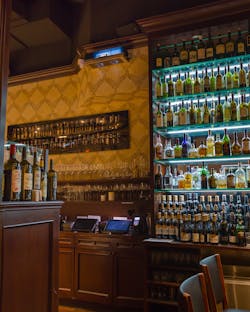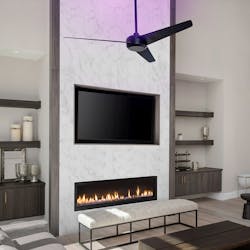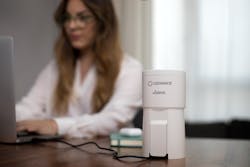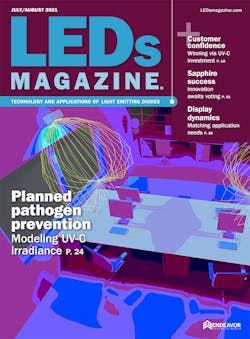UV-C uptake in commercial spaces remains sporadic despite pandemic (MAGAZINE)
Germicidal ultraviolet (GUV) radiation is an amazingly impressive disinfectant. The UV-C-band (100–280-nm) technology was thrust into the limelight with the onset of the coronavirus pandemic. Researchers correctly thought that UV-C radiation would instantly deactivate the SARS-CoV-2 virus and have since proven so in the lab. Now safely and effectively deploying such technology has not proven so smooth. Commercial building owners and facilities managers covering offices to restaurants to institutions have been slow to move toward large-scale UV-C installations. Thankfully, COVID-19 transmission is now headed in the right direction for society. And stakeholders in commercial buildings and other similar settings will face the decision as to whether new disinfection technology is a good investment.
This article is part of a UV special series we have presented starting in our January/February 2021 issue and concluding with this issue. We planned the series in the fall of 2020 when the pandemic outlook looked very bleak for global society. There was no significant evidence that vaccines would be available relatively quickly. Researchers were still arguing about transmission paths. And some states and regions were prioritizing economies over health. We certainly applaud the work of the research community and celebrate what has really become the best outcome imaginable during our fall 2020 planning.
In reality, UV-C has played a minor role in helping the world through a once-a-century pandemic. There just was not sufficient time for manufacturers to conceive and develop effective UV-C products and for building owners to adopt them. As we pointed out in our series back in the spring, medical facilities see UV-C as more important for fighting healthcare-associated infections (HAIs) than for deactivating SARS-CoV-2. And GUV has been evolving in those settings for years.
So where does the commercial building space stand now, and what do owners and facility managers do about germs in general going forward? We published a column earlier this year questioning whether interest in UV-C might wane with vaccinations underway. Moreover, Bob Karlicek, director of the Center for Lighting Enabled Systems & Applications (LESA) lab at Rensselaer Polytechnic Institute, had predicted UV-C research would return to the backburner in a UV-C webcast we held last year.
The proper course would be for manufacturers and the commercial real estate community to continue to purse efficacious GUV, perhaps at a more moderate yet consistent pace. The shrinking world, ongoing germicidal research, and bad actors around the globe are all cause for a belief that we won’t go a century before we experience the next pandemic.
What seems to be happening, however, is that the UV-C uptake will mostly be limited to applications where there is a return on investment (ROI) that isn’t tied to warding off the next pandemic. Let’s examine some pockets of success and also review some of the UV-C products on the market.
HVAC systems
We covered UV-C deployment in heating, ventilation, and air conditioning (HVAC) systems in our first article published in this series to start the year and focused on educational facilities. Placing UV-C sources inside air handlers and ducting seems ideal. Such installations shield the sources from human eyes and skin while deactivating airborne viruses, and as we all know now, COVID-19 was primarily passed by airborne transmission.
What we really didn’t know, even at the beginning of the year, was just how much research had been published on the use of UV-C in HVAC systems. For example, UV-C lamp manufacturer UV Resources published a detailed whitepaper on the topic in 2014 (review a PDF at https://bit.ly/2Ta6DFN). We found much earlier research in an academic journal.
UV-C deployment in commercial building HVAC systems is a perfect match for our earlier point about ROI. Yes, such installations will deactivate viral, bacterial, and fungicidal pathogens. And they will save money for the building owner. The UV-C keeps cooling coils clean, resulting in more efficient cooling, lower energy costs, and longer lifetimes for HVAC equipment.
There are numerous examples of HVAC-targeted UV-C products on the market. Some you insert through a round or rectangular hole in the ductwork with the electronics mounted on the exterior. Some have a fixture assembly. Some are essentially bare lamps. UV Resources, for example, offers the RLM Extreme that essentially looks like a fluorescent tube. It’s powered from one end by a remote driver. And it’s mounted with a couple of simple brackets inside ductwork or air handlers (Fig. 1).
Air quality
Still, it’s refreshing to learn about an HVAC deployment targeted more at air quality than ROI from energy and maintenance savings. Indeed, air quality does appear to be the motivation for a large project in the city of Santa Clarita, CA, located just north of Los Angeles. The city is in the process of adding UV-C into HVAC systems in 21 city-owned buildings ranging from City Hall to the public library.
The city has specifically discussed air quality as a motivation. Moreover, the region has been an area prone to California wildfires that can drastically increase air pollution. The retrofitted buildings that are all high-traffic facilities should be safer and more comfortable for the citizens.
Fresh-Aire UV is another manufacturer offering UV-C lamps and systems for commercial spaces spanning a broad scale of HVAC systems. The company touts deactivation of viruses such as SARS-CoV-2, and also reduction of volatile organic compounds (VOCs) that are the source of most unpleasant odors in buildings. That capability is in the company’s APCO Series of products that combine UV-C lamps with activated-carbon and titanium-dioxide filters to neutralize VOCs through photocatalytic oxidation (PCO).
Fresh-Aire also had a notable project with the APCO technology. An upscale Wellington, FL restaurant near West Palm Beach had Wagner’s Refrigeration and Air Conditioning install the system in the restaurant HVAC unit. “Like most business owners, we’ve felt a huge downturn because of the pandemic,” said David Baldwin, owner operator of Kaluz. “We’ve realized that we’ve got to do something to get our customers comfortable with coming back to indoor dining, especially with the hot summer coming back.” Clearly, the ROI in this case is keeping a business afloat via assurance to the customer of a clean environment.
Air circulation time
As you can see, there are good reasons for commercial buildings to install UV-C systems in HVAC. But deactivating a virus may not be at the top of the list. The issue with the HVAC system is the time it takes to bring active viruses to the UV-C sources. Air exchanges happen relatively slowly in a building-wide HVAC system. And a virus such as SARS-CoV-2 could be easily transmitted before the building-level system could work its magic.
We mentioned this concern in our prior coverage on UV-C, and the answer appears to be room-level UV-C systems and upper-air disinfection. That’s a process that can move air locally through a disinfection process much more quickly than can the HVAC system. Moreover, it’s an application ripe for LED sources as we covered in our prior UV-C Special Report.
There has been a lot of activity in the upper-air space in terms of new participants bringing products to market and even new approaches that remove the “upper” adjective from the scenario. There have been relatively fewer reports of installations. Again, it seems building owners and managers await more concrete data on germicidal efficacy and perhaps lower prices. As we mentioned in the coverage linked just above, the upper-air systems are expensive up front and even more expensive to operate continuously.
Reassure the customer
Then again, the capex and opex costs may prove perfectly reasonable if a business can reassure and win customers via the investment. Back to a restaurant example, the classic New York steakhouse called Rocco has installed an upper-air system made by Aerapy (Fig. 2). “Rocco Steakhouse goes above and beyond with our food, wine, and service and our customers expect no less from us when it comes to their health, which is why we chose Aerapy UV to further enhance our cleaning protocols,” said Pete Pjetrovic, owner and general manager. “Aerapy UV is designed to not only help take out the coronavirus but to improve overall indoor air quality for our customers and staff for the long term.”
The ceiling- and wall-mounted UV-C units include fans to enhance the natural convection effect that draws air upward. The impact is more rapid air exchange and less opportunity for viral transmission. The Zone360X products even include remote variable-speed fan control to move air faster when more customers are present.
Aerapy had also announced a project at Santander Bank in New York realized in conjunction with ECS Global Services (Fig. 3). “UV, and upper air UV in particular, has a successful history of helping prevent the spread of diseases and, as the current pandemic has progressed, so has our knowledge of how COVID-19 is spread,” said Annette Uda, founder and president of Aerapy. “Aerosols are now widely recognized as a key transmission route for SARS-CoV-2, the coronavirus that causes COVID-19, which is why keeping air sanitized is critical in indoor spaces like banks, offices, schools, retail spaces, and, of course, healthcare environments.”
Upper or lower
Then again, is there any real benefit to the adjective “upper” that precedes air? As we hinted earlier, some companies don’t think so. Upper-air systems evolved first and foremost because of safety. The systems are designed with baffles or other optical controls that produce a plane or blade of UV-C radiation perpendicular to the ceiling. The proper designs don’t radiate downward where the energy might damage skin or eyes. Moreover, UV-C photons don’t reflect off most surfaces. And then the aforementioned convective rise helps upper-air systems operate efficaciously in terms of disinfection.
Still, air disinfection could possibly be more effective if realized lower in the room closer to the source of the pathogens — expended breath. A manufacturer called Olympia Lighting is using LED sources to realize such a system. The company’s wall-mounted units can be easily installed and connected to a standard AC outlet. The LED sources are integrated inside the units in airflow chambers for safety.
There is also a company called Wavelength that makes UV-C air disinfection portable. The company offers a series of carts that can be easily wheeled into a space and connected with standard AC power. The company offers consulting services to help a customer devise a plan for how the carts are moved throughout a space during a day and how long they would operate in each location. One of the air disinfection carts can also convert into a surface disinfection unit for use without people present. And Wavelength offers dedicated surface-disinfection units also on wheels.
Perhaps, however, it is the ceiling and convection that makes the most sense. Established LED lighting manufacturer Modern Forms just recently announced what it calls the Ultra Germicidal Smart Fan — a ceiling fan with an LED-based UV-C module that radiates upward and outward, creating a plane of disinfection that air moves through (Fig. 4). The company is not the first to have such an idea. In our educational-focused story on UV-C from the beginning of the year, we covered a similar product from the Big Ass Fans company.
What we’ve learned in the past several months is that LEDs make a lot of economic sense in upper-air systems due to energy efficiency, and UV-C ceiling fans are one way to implement the technology. To Modern Forms, the concept looked like a new business opportunity. “We didn’t intend to enter the established ceiling fan market. Our friends in the industry told us it was futile for us to even try, but here we are,” said Dirk Wald, co-CEO of Modern Forms and WAC. “We realized that we could use technology to stir things up. And this is just the tip of the iceberg.”
Back to normal
Stepping back and looking at the commercial real estate space, one factor in the slow uptake of UV-C technology has been the lack of activity in businesses. Empty office buildings don’t need disinfection technologies. Now the world is crawling toward normal and the interest in UV-C and other safety technologies and practices could swell.
We’ve seen reports of many office buildings establishing road-like traffic patterns to keep employees spaced and moving through an office in one direction. In a couple of instances over the past few years we wrote about UV-C-based sanitization systems for escalator handrails. For example, Seoul Viosys said its Violeds UV-C LEDs were being used in such a product made by EHC Global.
We saw a report in the Toronto Life publication where an executive from the Dream property management firm said the firm had installed such handrail systems in downtown office buildings. The worry is that people will attempt to ride escalators without holding the rail, creating a different safety hazard. That article also mentioned UV-C robots such as we covered in our earlier article on healthcare facilities and also air filtration in elevators.
Getting personal
We will close with mention of a couple of products that are intended to deliver personal protection against airborne pathogens and that really show the breadth of what product developers have been thinking in the wake of the pandemic. LEDvance has introduced some UV-C T8 lamps that can be installed in fluorescent fixtures, although safe operation would require detailed procedures. But at the other end of the spectrum, the company announced the UVC HEPA Air Purifier (Fig. 5) — a product that an office worker could place on their desk. The company said the device will deal with microdust, pollen, smoke, and odors in addition to SARS-CoV-2.
Osram, now a part of ams Osram, is another company with a broad interest in UV-C. For now, the lamps business within Osram has ramped production of legacy UV-C lamps under the AirZing brand. But we also covered a portable device intended for use in an automobile that is also sold under the AirZing brand. The AirZing Mini is actually based on UV-A technology as opposed to UV-C, so it would not immediately deactivate SARS-CoV-2. But it would be effective against many pathogens over time.
LEDs Magazine chief editor MAURY WRIGHT is an electronics engineer turned technology journalist, who has focused specifically on the LED & Lighting industry for the past decade.
Enjoyed this article? Visit our digital magazine for more like this >>

Maury Wright | Editor in Chief
Maury Wright is an electronics engineer turned technology journalist, who has focused specifically on the LED & Lighting industry for the past decade. Wright first wrote for LEDs Magazine as a contractor in 2010, and took over as Editor-in-Chief in 2012. He has broad experience in technology areas ranging from microprocessors to digital media to wireless networks that he gained over 30 years in the trade press. Wright has experience running global editorial operations, such as during his tenure as worldwide editorial director of EDN Magazine, and has been instrumental in launching publication websites going back to the earliest days of the Internet. Wright has won numerous industry awards, including multiple ASBPE national awards for B2B journalism excellence, and has received finalist recognition for LEDs Magazine in the FOLIO Eddie Awards. He received a BS in electrical engineering from Auburn University.









![The DesignLights Consortium continues to make progress in shifting outdoor lighting products and implementation practices toward a more restrained and thoughtful strategy. [Image does not represent a DLC qualified fixture.] The DesignLights Consortium continues to make progress in shifting outdoor lighting products and implementation practices toward a more restrained and thoughtful strategy. [Image does not represent a DLC qualified fixture.]](https://img.ledsmagazine.com/files/base/ebm/leds/image/2024/08/66be810888ae93f656446f61-dreamstime_m_265700653.png?auto=format,compress&fit=&q=45&h=139&height=139&w=250&width=250)

